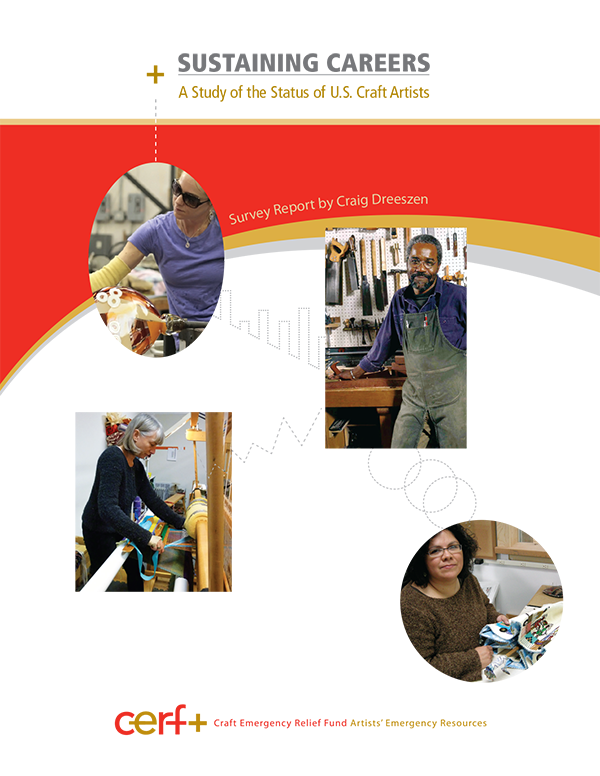Sustaining Careers: A National Study of the Status of U.S. Craft Artists
A national research study commissioned by CERF+ (Craft Emergency Relief Fund + Artists’ Emergency Resources), and conducted by Dreezen and Associates with grant support from the Windgate Charitable Foundation, is now available. Sustaining Careers: A National Study of the Status of U.S. Craft Artists, a follow-up to research conducted by CERF+ in 2004, reports the results of a survey of 3,500 American craft artists who were queried about trends, income, sales, insurance, emergency preparation and recovery, and plans for their legacy.
A Field in Flux: Quantitative survey results closely corresponded to more nuanced qualitative results of nine focus groups conducted nationwide by CERF+ in 2012 and 2013. The most commonly cited trend was the rapidly growing impact of technology on information exchange and the design, production, marketing, and sales of crafts — a trend with both opportunities and negative consequences. Technology coupled with the uncertainty of a weak economy, pressure from cheap imports and mass-produced goods, continuing erosion of art education, and the feeling that appreciation and respect for handmade crafts is diminishing paints a picture of a field in flux, seeking to redefine itself in a changing landscape.
Education: Over three-quarters (77 percent) of survey respondents were college graduates; 37 percent of that number held graduate degrees. About half received art or craft instruction in college, and half were self-taught or received training through workshops or apprenticeships. Over 80 percent of professional craft artists indicated that they did not receive adequate business or career-related instruction in college.
Income: Over half the artists surveyed (54 percent) worked full-time (30+ hours/week) at their craft. Nearly half (45 percent) of full-time craft artists netted less than $10,000 annually from their craft, around a quarter (27 percent) made $10,000–$25,000, just under a fifth (19 percent) earned between $26,000 and $50,000, and 9 percent made over $50,000 per year. About a quarter (24 percent) of full-time craft artists and 14 percent of all craft artists surveyed provided over 80 percent of their family income through their craft practice. Clearly, most craft artists depend heavily on income sources other than their artwork to make ends meet.
Compared with the results reported in CERF+’s 2004 survey, the current study found very similar income range patterns for gross business receipts for all craft artists.
Cash Reserves: Most financial planners recommend that families have cash reserves on hand to meet at least three to six months’ expenses. Forty seven percent had insufficient reserves to meet their expenses for one month, while 28 percent had one to three months’ reserves, and 25 percent had four or more months.
Business Insurance: A study of business insurance practices by craft artists, supported by the Windgate Foundation in 2007, found that 69 percent of craft artists surveyed were not properly insured for losses of business personal property (business assets excluding their building). One of the primary contributing factors to the low rate of insurance was a mistaken belief on the part of nearly a quarter of respondents that their homeowners’ or renters’ insurance provided coverage for their business property. While that myth persists, the current study indicates that there has been some improvement in the statistics, with about 9 percent more artists being properly insured for business losses.
CERF+ has been working (with Windgate Foundation support) to lessen barriers of information and availability identified in the 2007 survey. Of artists who have purchased insurance in the past two years, 35 percent cited the availability of an insurance product geared to artists as a contributing factor in the purchase, and 12 percent cited CERF+ communications or publications. Thirty-five percent cited a requirement by a show, and 24 percent a requirement for a commission or other opportunity as contributing factors in their purchase.
The Language of Craft: While the majority of respondents agreed that the word craft was a good way to describe their work, 46 percent disagreed. Some respondents reported that the word craft no longer conveyed their expertise or commitment to finely made objects to buyers, collectors, and the general public. Overwhelmingly, respondents preferred to be referred to as “artists,” with the medium followed by the word artist (glass artist, wood artist, etc.) or a medium-specific term such as potter or metalsmith. The term most strongly disliked, with 75 percent negative perceptions, was crafter.
The fifty-four-page study is available online at craftemergency.org.

